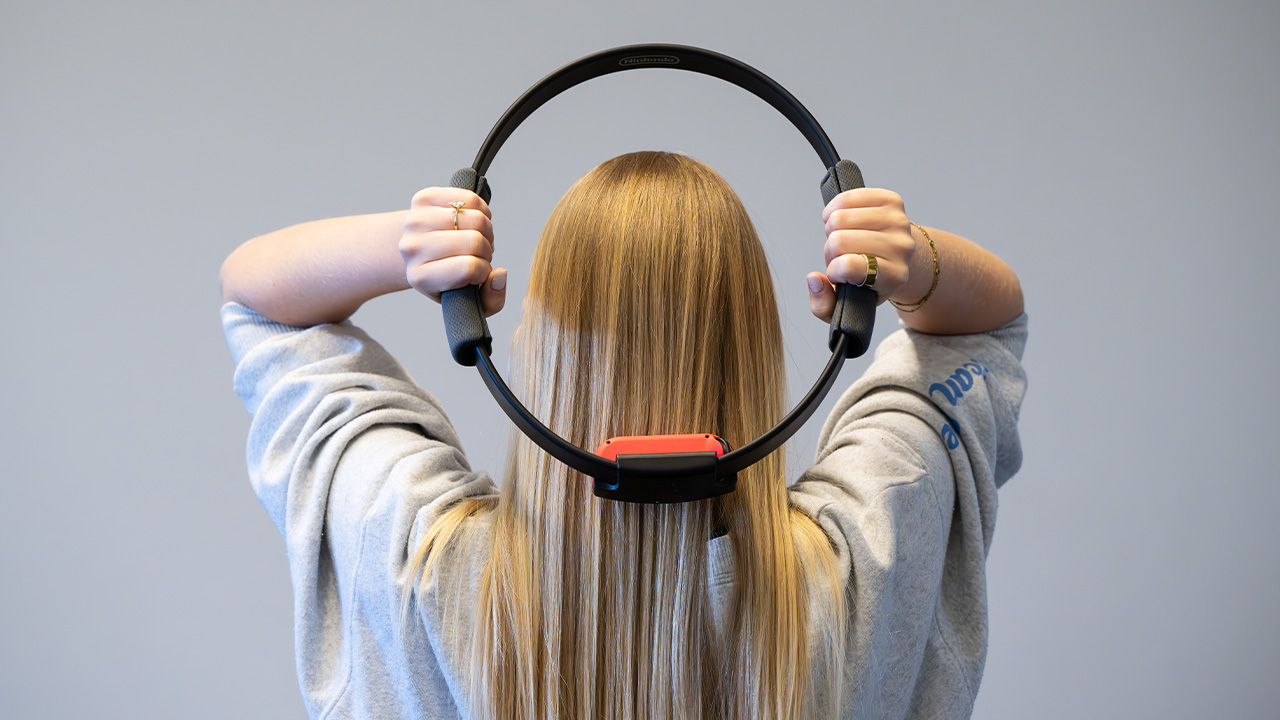content body
Danielle Wadsworth wants you to do just one thing: move.
“When we look at history over the last 100 years, you’ll see that humans have evolved to become very sedentary,” she said. “In the United States, fitness is a destination; you go to the gym, do your workout and then go home. But you should really move throughout the day, because fitness is meant to be a journey.”
A professor and the director of the Exercise Adherence and Obesity Prevention Lab in Auburn’s School of Kinesiology, Wadsworth is a prolific researcher who studies physical fitness and wellness in a range of audiences, including women, children and families. She focuses on finding solutions for integrating fitness in a busy world where technology rules and many of us spend long, inactive days indoors.

Student Lacy Smith demonstrates “Ring Fit,” an adventure-style video game in which participants battle a monster through resistance training and cardiovascular exercises.
Fitness for women
Past studies show women consistently get less exercise than men, at ages ranging from toddlers to senior citizens. While she’s always loved exercise herself, Wadsworth understands that women often must work harder than men to find their place in exercise.
“Whereas men automatically have a place in fitness, predominantly through sport, or they’re automatically accepted in a weight room, women don’t always have that same experience,” she said. “So, I think that's why I started studying exercise in women, and then I just keep backing it down to younger women and then children, because you want them to build those healthy habits early.”
While cardiovascular training is important, research shows it’s vital that women do resistance training to build bone mass, fight osteoporosis and maintain independence as they age. Resistance training can help women feel more capable in everyday life and may help women sustain exercise long-term.
“We know if people feel competent in exercising, they’re more likely to enjoy it and sustain things on their own,” she said. “A lot of our studies have found that resistance training builds those intrinsic-style motivators, and they’re more likely to exercise and stick with it. When you begin to lift weights, you feel more confident; you don’t need someone to get the box off the shelf for you, because you can do that all by yourself.”
Fitness for children
Wadsworth says researchers in the kinesiology field already know exactly which types of environments encourage children to be physically active. The problem is that those environments go against children’s natural rhythms of life in the U.S.
Video games are not her first choice for exercise, but as a busy researcher and a mom, she knows any amount of movement makes a difference.
“I consider this more of a desperation move, because it’s unrealistic to say, ‘let’s take technology away,’” she said. “That’s not where we are in society, so we need to figure out how we can stay healthy in conjunction with technology.
“Do I think this is the best way? No, but I do think it can be incorporated into a fitness routine, and it can be a great way to connect parents and kids.”
“You drive to school, you sit in school and movement is something you just do in PE. Then you go back and sit in class, and then you go home and sit to do homework, or you sit and play video games,” she said. “We really have to overcome our environment in the United States, because it’s not set up for us to be physically active.”
Wadsworth is currently conducting a study on the use of video games for exercise in which participating families play together on a Nintendo Switch at home. She’ll look for increases in children’s activity levels and ability to stay on task and how it changes family members’ connections to one another.
She’s using an adventure-style game called “Ring Fit,” in which participants battle a monster through resistance training and cardiovascular exercises. Wadsworth’s earlier studies with video games showed gains in lean body mass, strength and general fitness, and she’s expecting this one will, too.

Wadsworth is a professor and the director of the Exercise Adherence and Obesity Prevention Lab in Auburn’s School of Kinesiology.
Fitness for mental health
In addition to movement, Wadsworth is studying ways to integrate mental health into children’s school days with her colleagues Ford Dyke and Reita Clanton. They are currently creating resources on mindfulness for Auburn’s Gaining Early Awareness and Readiness for Undergraduate Programs (GEAR UP) Achieve initiative, which works to provide greater access and opportunities to more than 6,500 Alabama middle school students. These mindfulness lessons will allow teachers to focus on the social-emotional regulatory components of education in addition to academics.
“Between working with kids and having my own, I know the social-emotional part of schooling is one that can be ignored,” she said. “We’re really good at focusing on the academic side, but if kids aren’t healthy physically and mentally, it’s hard to be good academically. So, we’re just trying to provide that support system for students and teachers.”
Wadsworth, Dyke and Clanton are piloting the project with a small number of teachers this semester, but by fall, they’ll have a website with resources including audio files, comic books and worksheets so more educators can easily implement short mindfulness activities in the classroom. They’ll be studying the outcomes of mindfulness implementation with the help of teachers who decide to be research partners, but they also are happy to share the activities with any GEAR UP Achieve teachers who’d like to try them in the classroom.
“It will be appropriate for middle school to high school, which is the age group I don’t spend a lot of time with; they may actually be the hardest for researchers to get to,” Wadsworth said. “The activities we’re doing will be very easy to incorporate into any style class. We’ll be targeting PE classes, but there’s no reason an English teacher can’t start off with mindfulness before class.”
Any move will do
Wadsworth wants people to know it’s vital they find exercise they enjoy. Whether it’s a walk outside in the sunshine or a late-night fitness-oriented video game, there’s no wrong way to move, and the more we can incorporate fitness into our everyday lives, the healthier we’ll be.
“Movement is for everyone, and there are so many different types, so I encourage people to try new ones; go play pickleball, go to a dance class, hop on a YouTube video or just go for a walk,” she said. “It’s a gateway for other positive behaviors: reducing anxiety, reducing depression, improving social interaction. The more we can set up our environment to move, the better every single health outcome will be.”
Interested in learning more about exercise?
Check out the School of Kinesiology




